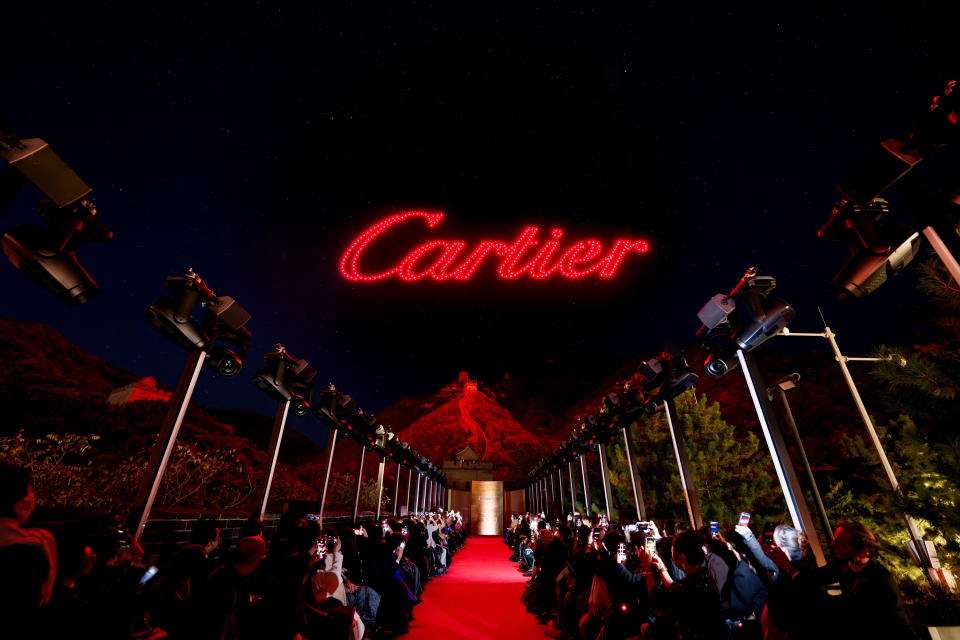Burberry Profit Downgrade Confirms Tough Times for Luxury

LONDON — Burberry’s profit downgrade has cast a pall over luxury’s quarterly reporting season, and made it clear that the high-end consumer is not in the mood to spend.
Last Friday, Burberry issued its Christmas trading update one week early, giving markets ample time to digest the news that adjusted operating profit for the 2024 financial year will land somewhere between 410 million pounds and 460 million pounds, below previously stated guidance.
More from WWD
Innovation, Investment: What's Next for New Materials at Biofabricate
Brands Race to Renew Royal Warrants Under New King and Queen
Later this week, it will be Compagnie Financiere Richemont’s turn to talk about trading in the key Christmas quarter. While no one is anticipating a downgrade, the markets will be watching for signs of slowing demand, and asking questions about the group’s plans for Yoox Net-a-porter after it called off the sale to Farfetch and Alabbar.
RBC Capital markets said that luxury brands’ fourth quarter and full-year 2023 results “could disappoint” and it expects to see a further moderation in earnings in the first half.
The bank added that in the first quarter of 2024, brands will likely see a “further revenue slowdown,” with companies including Swatch, Richemont, Kering and Burberry results under pressure.
The bank said it views LVMH Moët Hennessy Louis Vuitton as less vulnerable to the macro challenges, given its diversified model.

Morgan Stanley is expecting a similar to start to 2024, saying the first three calendar months “ought to prove a tough quarter for the sector, with a number of brands likely to post declines in growth year-on-year.”
Barclays is just as pessimistic. “Weak investor sentiment on the luxury goods sector still seems to dominate as the sector remains out of favor. After downgrading our industry view to ‘neutral’ in September, we remain cautious on the space, and still see risks to the downside when it comes to earnings.”
In early January, Barclays cut is earnings estimates and lowered its share price targets on Burberry, Hermès, Kering, Moncler and Richemont.
The bank reiterated its view that the luxury goods industry has entered a phase of “normalization, which should fully materialize in 2024.”
It expects organic growth in the industry to be up midsingle-digit, mostly driven by the return of Chinese tourists, “while demand from other key nationalities, notably European and American, could remain subdued.”
Barclays added the brands won’t even be able to fuel sales with price hikes following “several years of high-single-digit to double-digit price increases.”
Nora Kleinewillinghoefer, a partner at Kearney, said she is expecting midsingle-digit growth in 2024, compared with 11 percent over the past three years.
Drilling down, she added that leather goods, jewelry and timepieces will likely show “more resilience, indicating a preference toward classic investment pieces that retain more value.”
That bodes well for Richemont, which sells mostly hard luxury and leather goods.
Burberry, by contrast, is still building up its high-end accessories offer, and most of its sales still come from clothing.
Burberry felt the full weight of the worldwide slowdown in luxury demand in its fiscal third quarter ended Dec. 30, and waning demand prompted the company to warn on profits for the second time in three months.
In November, Burberry had already said that full-year profits would be lower due to a wider slowdown in demand for luxury goods worldwide. At the time, Burberry said that adjusted operating profit would be at the “lower end” of a consensus range between 552 million pounds and 668 million pounds.
Despite this month’s profit downgrade, chief executive officer Jonathan Akeroyd said he was confident that Burberry could reposition the brand under designer Daniel Lee, whose first runway collection began landing on the shop floor last September.
Akeroyd is also convinced that Burberry will reach its medium-term goal of reaching 4 billion pounds in revenue, but acknowledged the wider economic backdrop would make the task more challenging.
“Clearly luxury demand has slowed, but we are still in the very early stages” of the repositioning, he said. “It’s very early days, and we have a long way to go. We’re focused on execution, and we’re very confident in our strategy.”
To wit, Burberry is planning a large-scale takeover of Harrods starting Feb. 1, filling the windows, and covering the facade in the brand’s new shade of blue. It has also created an exclusive collection and planned various in-store activities as part of the event, which will be full flower during London Fashion Week.

On Friday, following the downgrade, RBC Capital Markets said it viewed Burberry’s mid-term revenue target of 4 billion pounds and projected margin of 20 percent as “optimistic, at this stage. Our estimates are materially below these levels” by fiscal 2028, the bank said.
Luca Solca of Bernstein was also pessimistic. “There did not appear to be an obvious bright spot in the results, with European, Chinese and American nationals all disappointing versus the company’s expectations,” he wrote.
Solca added: “The company hopes that footfall will improve, that the macro environment will become a little easier, and that Daniel Lee’s collections will spur a revitalization. This optimism does not appear consistent with the weakness seen in December. Alas, hope is not a strategy.”
Akeroyd also shed light on consumer spending in the quarter, saying demand from European locals was “disappointing,” while America is “still challenged.” He added that in America the dwindling appetite for luxury goods had begun to spread beyond the aspirational consumer to the bigger spenders.
Traffic in China, he added, was still soft, with Burberry witnessing a “deceleration” in sales in December.
Akeroyd also noted that Lunar New Year starts on Feb. 10, three weeks later than in 2023. That timing might have had an impact on Chinese consumers’ reluctance to splash out at Christmas.
On a brighter note, Chinese consumers have begun to trickle back to Europe, and now represent 8 percent of shoppers in the region. But that is still well below pre-pandemic levels.
Asked about Burberry’s pricing strategy, Akeroyd said the brand would continue to align itself with its luxury peers as part of its overall repositioning.
In terms of prices, he said “we’re confident about where we are at the moment,” and that Burberry had no plans to lower prices in response to the slowdown in demand.
Retail revenue in the third quarter was down 7 percent to 706 million pounds at reported exchange rates. At constant exchange, it fell 2 percent.
Comparable stores sales were down 4 percent, a larger drop than the banks had anticipated.
Consensus estimates were for a 3 percent decline, while Barclays said it was expecting a 2 percent drop. The banks had expected Burberry to perform better in China, given easier comparisons with the corresponding period last year.
In Asia Pacific overall, comparable store sales were up 3 percent. Specifically, mainland China rose 8 percent; Japan 9 percent, and South Asia Pacific 2 percent. In South Korea, sales were down 10 percent.
In the EMEIA region, which comprises Europe, the Middle East, India and Africa, sales were down 5 percent. In the Americas they dropped 15 percent.
Burberry’s profit downgrade, and snapshot of tepid demand for luxury in the runup to Christmas, dovetails with analysts’ projections for the sector in 2024.
Earlier this month, Jefferies released a report called “The Asperity Of Prosperity,” which argued the upcoming reporting season will “highlight the risk of another year of U.S. normalization; ongoing weakness in Europe, and the possibility of a limited boost from travel to Chinese spend.”
Based on data from December, Jefferies argued that the U.S. market has entered “a second year of normalization” with regard to luxury spend, and that Chinese consumers are exercising greater caution in their purchasing.
Jefferies added that its own previous assumption of a 13 percent uptick in Chinese spend due to travel recovery in 2024 now looks “optimistic.”
As reported earlier this month, luxury brands and retailers are expecting a challenging 2024 as aspirational consumers worldwide continue to pull back on spending in what remains an uncertain macro-economic climate.
With wars grinding ahead in Ukraine and the Middle East, and with the U.S. and the U.K. headed to the polls later this year, consumers are — understandably — anxious, and ever more cautious about spending.
With interest rates still high and questions swirling about the Chinese consumer’s appetite for luxury, analysts have been conservative in their outlook for the year.
HSBC called its 2024 outlook report “Goodbye Stellar Growth” and said the normalization in the sector could stretch into 2025.
“Following three years [2021 to 2023] of exceptional growth linked to revenge buying in almost all regions after the reopening post COVID-19, we are now expecting a return to normalized growth in 2024 and 2025,” the bank wrote.
The bank said it is expecting 8 percent average growth for the companies it covers for 2024 and 2025, compared with 35 percent in 2021; 15 percent in 2022, and 11 percent in 2023.
Overall, analysts believe it will be a lackluster year for the big brands, with organic growth projections ranging between 4 percent and 8 percent, and sales weighted toward the second half of 2024.
On Monday, Burberry shares closed down 6 percent at 12.12 pounds, while the big luxury groups Richemont, Kering and LVMH were broadly flat.
Best of WWD


